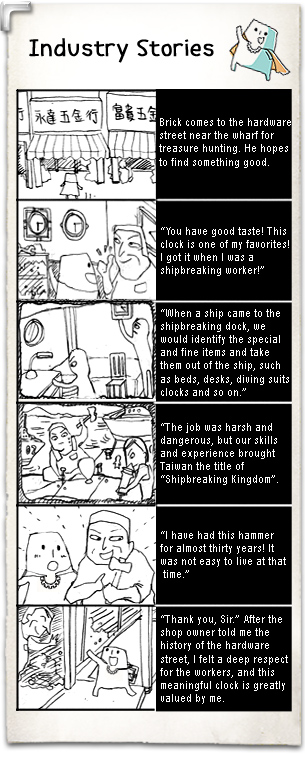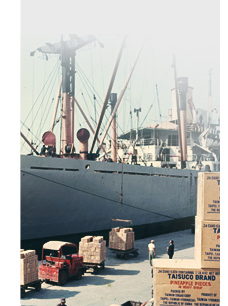|
 The older generation in Kaohsiung knows that the ship breaking industry had flourished in the post-war era (1950s to 70s). And as the forerunner of Taiwan’s steel industry, it had led to the development of the famous “Hardware Street”, Kaohsiung’s Guanyuan Road. In fact, the original ship breaking industry was a result of war due to the large number of damaged or sunken vessels. In the later stage of World War II, in order to prevent attacks from the U.S. Navy, the Japanese army utilized sunken vessels to lockout the ports in Kaohsiung and Keelung, allowing access only to small vessels. According to the statistics, there were about 178 different sizes of sunken ships. After the defeat of the Japanese, the Nationalist government encouraged people to participate in the work of port cleaning in order to dredge the port as quickly as possible, thereby contributing to the rapid rise of the salvage industry and marking the beginning of the history of Taiwan’s ship breaking industry. The older generation in Kaohsiung knows that the ship breaking industry had flourished in the post-war era (1950s to 70s). And as the forerunner of Taiwan’s steel industry, it had led to the development of the famous “Hardware Street”, Kaohsiung’s Guanyuan Road. In fact, the original ship breaking industry was a result of war due to the large number of damaged or sunken vessels. In the later stage of World War II, in order to prevent attacks from the U.S. Navy, the Japanese army utilized sunken vessels to lockout the ports in Kaohsiung and Keelung, allowing access only to small vessels. According to the statistics, there were about 178 different sizes of sunken ships. After the defeat of the Japanese, the Nationalist government encouraged people to participate in the work of port cleaning in order to dredge the port as quickly as possible, thereby contributing to the rapid rise of the salvage industry and marking the beginning of the history of Taiwan’s ship breaking industry.
Salvaging the sunken ships was done by taking advantage of the proportion of air and water. Iron tubes were chiseled around the ship and then compressed air was used to squeeze the water out of the tubes, so that the wrecked ship can be pulled up. Sometimes, the divers would tie cables to the entire ship, fastening and welding it directly on the seabed, and then use cranes to lift the ship out of the water. Salvaging the sunken ships contributed to the rise of the ship breaking industry. From dismantling the body, lifting and suspension, and other labor-intensive activities involved in cutting, ship breaking workers risked their safety time and again working with the heavy steel blocks, and accumulated skills and experience from these dangerous tasks. Normally, tearing down a ship of 300, 000 tons requires about 150 to 180 days in advanced countries, but only takes 30 days in Taiwan. With short-term profit incentives, hard-working laborers, and policy support, Taiwan’s ship breaking industry began accepting a large number of international commissions, and earned the status of “ship breaking kingdom” in 1968.
Behind this seemingly glorious title, the image of the industry is actually composed not only of the bourgeois, but also a group of anonymous workers, scrap metal collectors, small vendors, and sea pigs. At the port side, the salty smell of the sea mixed with the sweat of the workers. At the same time, the workers were dwarfed by the enormity of the ship bodies. Rumbling noise was emitted from the clashing steel blocks and sparks flew from electronic cutters; the air was filled with oil, rust and a charred smell. Workers who worked in an environment with minimal protective measures were bound to be well-trained and physically strong, despite the scars hidden under the sun-baked skin. In an environment filled with heat, dirt, dust, and noise, accidents and explosions may occur if workers are not careful enough.
After the disintegration, a variety of materials, such as iron, lead, machine parts, scrap metal, used beds, tables and clock, were sold to various vendors. The used ship plates and scrap wood salvaged from ship breaking became the raw materials for Taiwan’s early iron and steel industry, such as ship plates for steel-rolling, scrap metal for EAF steel-making, iron mills for casting, and copper and alloys for renewable smelting. The industrialization and transformation of modern life was based upon the development of the iron and steel industry. Modern day skyscrapers, transportation vehicles, railways, and bridges are all available due to the development of steel technology. While enjoying the convenience brought about by industrialization, we must not forget those who risked their lives and safety to fulfill our need for greater convenience.
Note 1: After the war in 1947, the National Government of the Republic of China developed laws and implementation details, encouraging the private sector to participate in the work of cleaning up the ports.
Note 2: Based on the interviews, the profit of ship breaking industry, if (i.e., without major accident or impacted by falling international steel price), was very impressive. Many investors became wealthy. In 1965, the International Trade Bureau drew Measures of Rewarding Imported Old Vessels that had largely motivated the industry. In 1973, the imported old vessel for demolition was included in the “Special Case of Financing” project that contributed to the development of the ship breaking industry in international trade.
Note 3: Pier Scavengers are commonly known as “Sea Pigs,” riding a small boat or diving into the sea to pick up bits of cut off materials left in the water.
Note 4: The most serious incident occurred on August 11, 1986, when the Qana Oil Tanker exploded at the ship breaking dock in Daren District of Kaohsiung. The casualties amounted to over 100 people, gradually shattering the golden dream of ship breaking.
|
